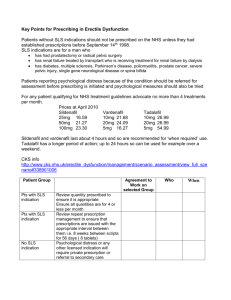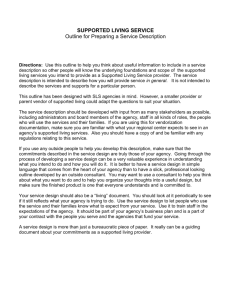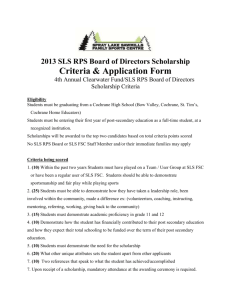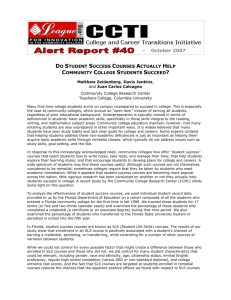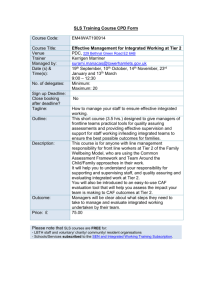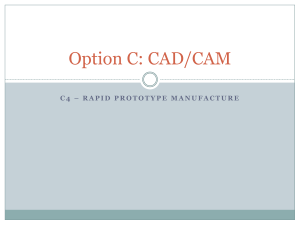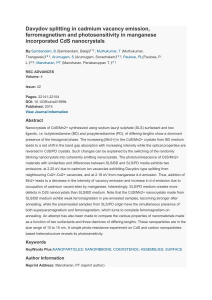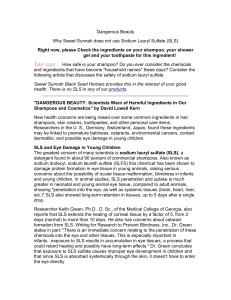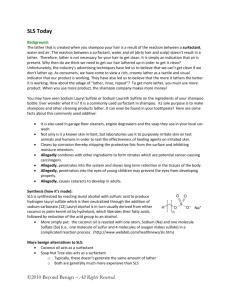Draft questions and answers on sodium laurilsulfate in the
advertisement
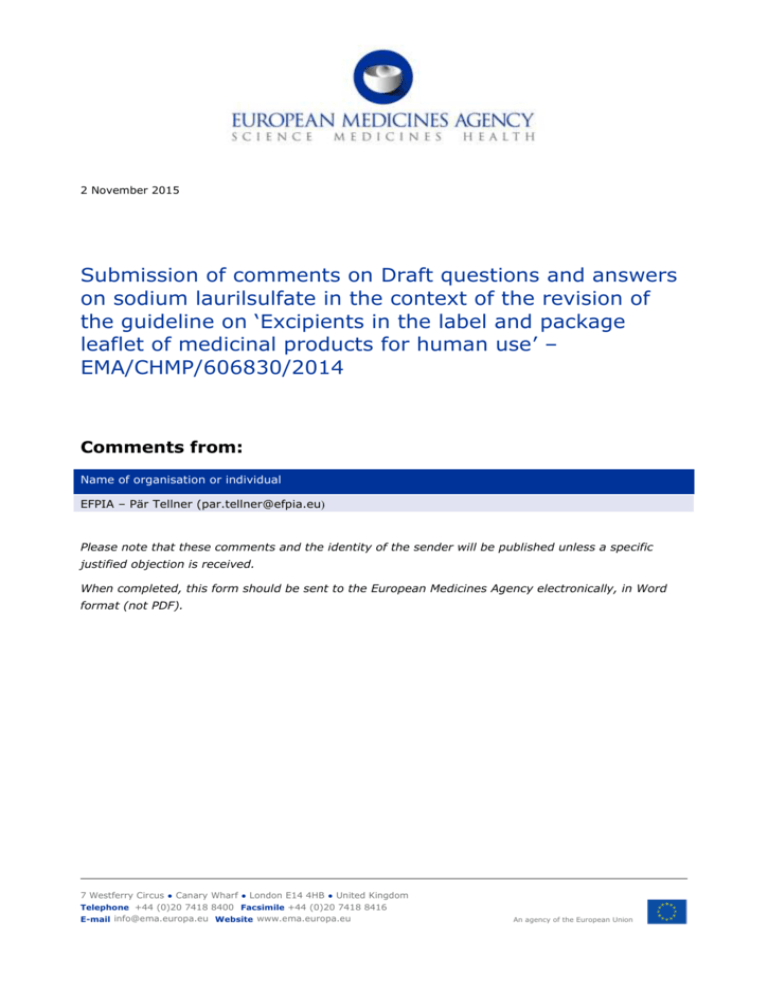
2 November 2015 Submission of comments on Draft questions and answers on sodium laurilsulfate in the context of the revision of the guideline on ‘Excipients in the label and package leaflet of medicinal products for human use’ – EMA/CHMP/606830/2014 Comments from: Name of organisation or individual EFPIA – Pär Tellner (par.tellner@efpia.eu) Please note that these comments and the identity of the sender will be published unless a specific justified objection is received. When completed, this form should be sent to the European Medicines Agency electronically, in Word format (not PDF). 7 Westferry Circus ● Canary Wharf ● London E14 4HB ● United Kingdom Telephone +44 (0)20 7418 8400 Facsimile +44 (0)20 7418 8416 E-mail info@ema.europa.eu Website www.ema.europa.eu An agency of the European Union 1. General comments Stakeholder number General comment (if any) (To be completed by Outcome (if applicable) (To be completed by the Agency) the Agency) EFPIA welcomes the opportunity to comment on this draft questions and answers on sodium laurilsulfate in the context of the revision of the guideline on ‘Excipients in the label and package leaflet of medicinal products for human use’. We concur with the suggestion at line 65 that the skin irritancy associated with sodium laurilsulfate (SLS) is likely to be due to its surfactant properties. This is a common effect associated with sodium soaps. It is mild, reversible, and well understood after centuries of use in the domestic setting. The Registry of Toxic Effects of Chemical Substances (RTECS) lists 30 eye and skin irritation studies conducted with SLS in a variety of mammalian species including human. Mild skin irritation is the predominant finding. The European Chemicals Agency (ECHA) database of registered substances lists one key and 10 supporting studies. Again, mild irritation is the predominant finding. The conclusion of sensitising studies is that SLS is not a sensitiser. However, we would like to express our concerns with the proposed guidance. First, we concur with the point at line 89 that a threshold for irritant effects is difficult to determine. However, it should be noted that all the studies reported on the ECHA website relate to concentrations of 1% up to 100% SLS in the test formulation, the majority of studies being at 20% or greater. Empirical experience of the behaviour of soaps indicates that irritancy effects must be thresholded, and the fact that the cosmetics industry 2/6 Stakeholder number General comment (if any) (To be completed by Outcome (if applicable) (To be completed by the Agency) the Agency) uses SLS as a positive control is not, in itself, sufficient rationale to conclude that a zero threshold is appropriate. The only evidence cited, at line 71, concerns products with SLS at 0.9%. By way of example, for one widely marketed topical cream product, containing SLS at 0.25% w/w, the MAH has examined the pharmacovigilance data set for the product, which has been authorised for several decades, and finds no evidence of reports of an irritant effect above the expected background level. Labelling this product with a new warning is not warranted as a result of a comprehensive examination of directly relevant human pharmacovigilance data specific to this product, and would introduce significantly confusing issues for the patient and prescriber given that the indications for this product manifest with itching, irritation and sensitivity. Overall, whilst a recommended threshold for SLS in topical products is difficult to establish, given the range of confounding factors, we feel that a 0% threshold is inappropriate and unnecessary. Low levels of SLS can be added to raw materials as process aid. As it’s not stated as a general exclusion in the excipient guideline, the 0% threshold would require MA Holders to establish from their raw material suppliers whether SLS was present as an additive. Given that trace amounts of SLS are unlikely to result in skin irritation, even in the presence of other known irritants, it may be better in the long-term to establish a non-zero threshold. Second, the guidance appears significantly precautionary in its approach. As line 68 makes clear, the association of SLS with irritancy in formulated medicinal products is not well understood. We feel a precautionary approach is 3/6 Stakeholder number General comment (if any) (To be completed by Outcome (if applicable) (To be completed by the Agency) the Agency) warranted where the effects are severe, or nonreversible, or difficult to control using standard techniques. None of those criteria apply here, and an evidence based approach would be more appropriate, since precautionary labelling inevitably carries a cost of reducing patient access to potentially very beneficial products which may have decades of use supporting an acceptable risk benefit profile. Given that the hazard, if there is one associated with formulated medicinal products, is mild, reversible, and easily managed using conventional approaches, the applicant urges that more consideration be given to the implications of labelling change, before elaborating an evidence- based guidance. We believe that this is strongly preferable to elaborating guidance now which relies on a precautionary approach justified by several speculative elements including read across from a different sector using SLS for different purposes and at different concentrations. We advocate that the proposed text for the package leaflet should not be added retrospectively on labels of topical products where it has been demonstrated through post-marketing safety data that the incidence levels of SLS associated adverse events is low. The current Questions and Answers document provides standard text for inclusion the package leaflet; we propose that corresponding standard text for inclusion in the prescriber information (SmPC), also be provided. 4/6 2. Specific comments on text Line number(s) of the relevant text (e.g. Lines 20- Stakeholder number Comment and rationale; proposed changes Outcome (To be completed by (If changes to the wording are suggested, they should (To be completed by the Agency) the Agency) be highlighted using 'track changes') 23) Line 91-92 “...It is, therefore, proposed to have a threshold of 0% for SLS in topical medicinal products for all age groups...” Comment: As discussed under the general comments, a 0% threshold may be inappropriate and would be burdensome in practice. It would necessitate drug product manufacturers and, more significantly, excipient suppliers to confirm whether or not SLS was present as an additive in their product. The removal of SLS may cause difficulties in the manufacture of raw materials and or finished product. Proposed change (if any): We propose a reassessment and amendment of the 0% threshold proposed. 93 Information for the Package Leaflet: “This product contains sodium laurilsulfate x% w/w. Sodium laurilsulfate may cause local skin reactions (such as stinging or burning sensation) in particular if you have sensitive skin.” Comment: Revised wording is proposed for improved readability and comprehension. For example, to explain that sodium laurilsulfate is soap, rather than just using the chemical name, which may mean nothing to a lay person. Also patients may not understand the term “local skin reactions”. Proposed change (if any): “This medicine product contains sodium laurilsulfate x% w/w., 5/6 Line number(s) of the relevant text (e.g. Lines 20- Stakeholder number Comment and rationale; proposed changes Outcome (To be completed by (If changes to the wording are suggested, they should (To be completed by the Agency) the Agency) be highlighted using 'track changes') 23) which is found in many household cleaning products such as soap. Sodium laurilsulfate may cause skin problems local skin reactions (such as stinging or a burning sensation), in particular if you have sensitive skin.” 93 Information for the Package Leaflet: “May increase local reactions caused by other medicines when applied to the skin in the same area.” Comment: As the wording does not give any guidance to the patient, revised wording is proposed for improved clarity and readability, and so that the sentence is grammatically correct. Proposed change (if any): “May increase local reactions caused by other medicines when applied to the skin in the same area. If you apply this medicine to the same place as other medicines that irritate your skin, it might irritate your skin even more.” Please add more rows if needed. 6/6
